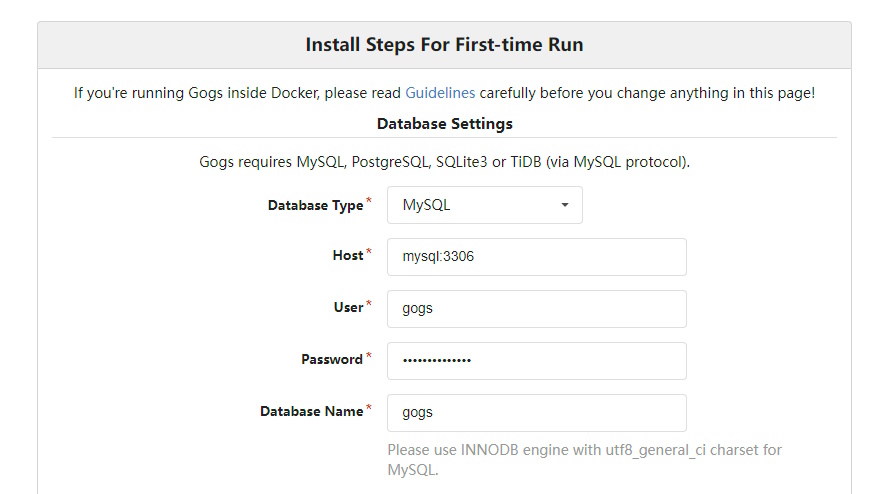Setup GOGS using MySQL in Docker

What is GOGS?
The GOGS project aims to build a simple, stable and extensible self-hosted Git service that can be set up in the most painless way.
Features
- User dashboard, user profile and activity timeline.
- Access repositories via SSH, HTTP and HTTPS protocols.
- User, organization and repository management.
- Repository and organization webhooks, including Slack, Discord and Dingtalk.
- Repository Git hooks, deploy keys and Git LFS.
- Repository issues, pull requests, wiki, protected branches and collaboration.
- Migrate and mirror repositories with wiki from other code hosts.
- Web editor for quick editing repository files and wiki.
- Jupyter Notebook and PDF rendering.
- Authentication via SMTP, LDAP, reverse proxy, GitHub.com and GitHub Enterprise with 2FA.
- Customize HTML templates, static files and many others.
- Rich database backend, including PostgreSQL, MySQL, SQLite3 and TiDB.
- Have localization over 31 languages.
Why run a self-hosted Git service when you have one or more Github accounts?
Simple really. There are some things which need version control but are too sensitive, use case specific or simply too embarassing (we all have code like that) to publish to Github or any public Git service.
Personally, I use GOGS to store my Ansible setup (including username/passwords) to simplify deployments. I also use it for “Internal” projects i.e. scripts, software that are solely of use to me. Honestly, I have no embarassing code :winking_face_with_tongue:
Seeing as I run all my local services in Docker, inside an LXC container on Proxmox, running GOGS as a Docker container made sense. I also have a MySQL database for various other projects so reusing that also made sense. My biggest issue was that most of the tutorials were based around Postgres SQL server.
Basic Docker Compose file
---
services:
## MySQL 8.0
mysql:
image: mysql:8.0
container_name: mysql
restart: unless-stopped
environment:
MYSQL_ROOT_PASSWORD: SECRET_MYSQL_ROOT_PASSWORD
volumes:
- ./mysql/data:/var/lib/mysql
networks:
customnetwork:
ipv4_address: 10.1.1.2
## GOGS
gogs:
container_name: gogs
image: gogs/gogs:latest
restart: unless-stopped
ports:
- 80:3000
volumes:
- ./gogs/data:/data
- ./gogs/backups:/backup
environment:
- RUN_CROND=true
- BACKUP_INTERVAL=1d
- BACKUP_RETENTION=14d
depends_on:
- mysql
networks:
customnetwork:
ipv4_address: 10.1.1.3
networks:
customnetwork:
ipam:
config:
- subnet: 10.1.1.0/24
MySQL Setup

MySQL needs to be set up with a gogs database and user prior to running through the GOGS installation process.
NOTE: Please choose a strong, secure root password above.
Create database and user
To create the database you need to connect to the MySQL Docker container and run some SQL commands.
docker exec -it mysql /bin/bash
Form there execute…
mysql -u root -p
Use the SECRET_MYSQL_ROOT_PASSWORD from the docker-compose.yml file.
Once inside the MySQL commandline client run the following SQL commands…
SET GLOBAL innodb_file_per_table = ON;
DROP DATABASE IF EXISTS gogs;
CREATE DATABASE IF NOT EXISTS gogs CHARACTER SET utf8mb4 COLLATE utf8mb4_general_ci;
CREATE USER 'gogs'@'%' IDENTIFIED BY 'StrongPassword';
GRANT ALL PRIVILEGES ON gogs.* TO 'gogs'@'%';
FLUSH PRIVILEGES;
\q
Please choose a proper StrongPassword for the gogs user.
Setup GOGS

Connect to the host IP address on the port exposed by the docker-compose.yml file, in the example above it’s port 80, and you’ll be presented with the First-time Run page.

Database Settings
| Setting | Value |
|---|---|
| Database Type | MySQL |
| Host | mysql:3306 |
| User | gogs |
| Password | StrongPassword |
| Database Name | gogs |
Application General Settings
I only change some of these settings. I like to persist the log files hence changing the Log Path
| Setting | Example Values |
|---|---|
| Application Name | My Private Git Repository |
| Application URL | https://mygitrepo.tld |
| Log Path | /data/log |
| Default Branch | main |
NOTE: If specifying an HTTPS Application URL then GOGS must be hosted behind an HTTPS Proxy like Nginx Proxy Manager, Traefik, HAProxy, Cloudflare Zero Trust, etc. as it doesn’t directly support HTTPS connections.
Optional Settings
I like to fill in the Email Service Settings.
SMTP Host is in the format of smtp.gmail.com:587
Under Server and Other Services Settings I tend to only check 2 options, Disable Self-registration and Enable Require Sign In to View Pages if I’m setting up an internal, private Git server.
And finally under Admin Account Settings I always set up an Administrative account that WONT be used to commit changes to any repositories. Later I’d create a non-Adminastrative user to do all the Repository creation and commits to Git.
NOTE: If Enable Require Sign In to View Pages is enabled then the Docker container WILL need to be restarted for it to take effect.
Once finished click the blue Install GOGS button. This will now complete the installation and log you in as the Administrative User if one was set up.
From here you’ll be able to create non-Administrative users and start using your Git server.
Backup/Restore
As configured above in the docker-compose.yml file backups will occur once per day and retain 14 days worth of backups under the ./gogs/backups volume. The backup process will produce a gogs-backup-[TIMESTAMP].zip daily.
To restore a backup simply execute the following command:
docker exec -it gogs /app/gogs/gogs --from="gogs-backup-xxx.zip"
Further information about backups can be found at the discussion page “How to backup, restore and migrate” on the GOGS Github Repository.
Conclusion
I’ve been running an internal GOGS server for a number of years now and while it doesn’t contain all the features bigger platforms like Github, Gitlab and Forgejo possess, it’s small, compact nature fits the bill (for me) perfectly.
Honestly, some of the settings I’ve outlined above are personal preferences but it’s how I like to set up a personal, internal and private Git Server. GOGS is fantastic, lightweight and similar enough to Github that using it is really easy.
Hopefully someone will find this useful and give GOGS a go as their own personal Git Server.
Written by Alan Doyle
August 9, 2023.